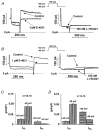The role of the delayed rectifier component IKs in dog ventricular muscle and Purkinje fibre repolarization
- PMID: 10675203
- PMCID: PMC2269783
- DOI: 10.1111/j.1469-7793.2000.00067.x
The role of the delayed rectifier component IKs in dog ventricular muscle and Purkinje fibre repolarization
Abstract
1. The relative contributions of the rapid and slow components of the delayed rectifier potassium current (IKr and IKs, respectively) to dog cardiac action potential configuration were compared in ventricular myocytes and in multicellular right ventricular papillary muscle and Purkinje fibre preparations. Whole-cell patch-clamp techniques, conventional microelectrode and in vivo ECG measurements were made at 37C. 2. Action potential duration (APD) was minimally increased (less than 7%) by chromanol 293B (10 microM) and L-735,821 (100 nM), selective blockers of IKs, over a range of pacing cycle lengths (300-5000 ms) in both dog right ventricular papillary muscles and Purkinje fibre strands. D-Sotalol (30 microM) and E-4031 (1 microM), selective blockers of IKr, in the same preparations markedly (20-80%) lengthened APD in a reverse frequency-dependent manner. 3. In vivo ECG recordings in intact anaesthetized dogs indicated no significant chromanol 293B (1 mg kg-1 i.v.) effect on the QTc interval (332.9 +/- 16.1 ms before versus 330.5 +/- 11.2 ms, n = 6, after chromanol 293B), while D-sotalol (1 mg kg-1 i.v.) significantly increased the QTc interval (323.9 +/- 7.3 ms before versus 346.5 +/- 6.4 ms, n = 5, after D-sotalol, P < 0.05). 4. The current density estimated during the normal ventricular muscle action potential (i.e. after a 200 ms square pulse to +30 mV or during a 250 ms long 'action potential-like' test pulse) indicates that substantially more current is conducted through IKr channels than through IKs channels. However, if the duration of the square test pulse or the 'action potential-like' test pulse was lengthened to 500 ms the relative contribution of IKs significantly increased. 5. When APD was pharmacologically prolonged in papillary muscle (1 microM E-4031 and 1 microg ml-1 veratrine), 100 nM L-735,821 and 10 microM chromanol 293B lengthened repolarization substantially by 14.4 +/- 3.4 and 18. 0 +/- 3.4% (n = 8), respectively. 6. We conclude that in this study IKs plays little role in normal dog ventricular muscle and Purkinje fibre action potential repolarization and that IKr is the major source of outward current responsible for initiation of final action potential repolarization. Thus, when APD is abnormally increased, the role of IKs in final repolarization increases to provide an important safety mechanism that reduces arrhythmia risk.
Figures










References
-
- Antzelevitch C, Sicouri S, Litovsky SH, Lukas A, Krishnan SC, van Diego JM, Gintant GA, Liu DW. Heterogeneity within the ventricular wall. Electrophysiology and pharmacology of epicardial, endocardial, and M cells. Circulation Research. 1991;69:1427–1449. - PubMed
-
- Billman GE, Houle MS, Lynch J. Selective IKs blockade protects against ventricular fibrillation induced by myocardial ischaemia. European Heart Journal. 1998a;19:17. Abstract suppl.
-
- Billman GE, Houle MS, Lynch J. Selective IKs but not IKr blockade protects against ventricular fibrillation induced by myocardial ischaemia. Circulation. 1998b;98:I-52.
-
- Bosch RF, Gaspo R, Busch AE, Lang HJ, Li GR, Nattel S. Effects of the chromanol 293B, a selective blocker of the slow component of the delayed rectifier K+ current on repolarisation in human and guinea pig ventricular myocytes. Cardiovascular Research. 1998;38:441–450. - PubMed
-
- Bryant SM, Wan X, Shipsey SJ, Hart G. Regional differences in the delayed rectifier current (IKr and IKs) contribute to the differences in action potential duration in basal left ventricular myocytes in guinea-pig. Cardiovascular Research. 1998;40:322–331. - PubMed
Publication types
MeSH terms
Substances
LinkOut - more resources
Full Text Sources

